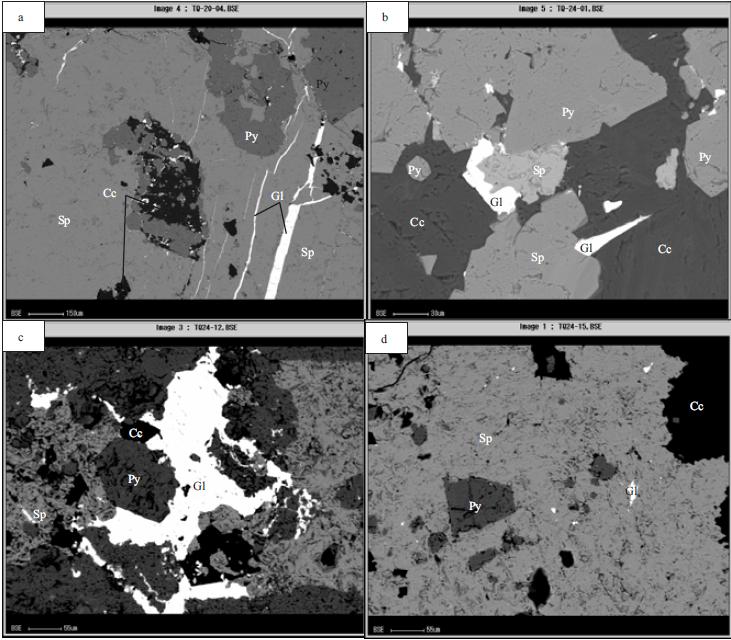| Trace Elements and Rare Earth Elements of Sulfide Minerals in the Tianqiao Pb-Zn Ore Deposit, Guizhou Province, China |
TEXT SIZE: A A A |
| |

Fig. Back-scattered electron images. a) Banded galena, and calcite and pyrite in sphalerite; b) galena, pyrite, sphalerite, and calcite paragenesis; c)replacement remnant sphalerite and galena; d) automorphic pyrite and replacement remnant sphalerite
Trace elements and rare earth elements (REE) of the sulfide minerals were determined by inductively-coupled plasma mass spectrometry. The results indicate that V, Cu, Sn, Ga, Cd, In, and Se are concentrated in sphalerite, Sb, As, Ge, and Tl are concentrated in galena, and almost all trace elements in pyrite are low. The Ga and Cd contents in the light-yellow sphalerites are higher than that in the brown and the black sphalerites. The contents of Ge, Tl, In, and Se in brown sphalerites are higher than that in light-yellow sphalerites and black sphalerites. It shows that REE concentrations are higher in pyrite than in sphalerite, and galena. In sphalerites, the REE concentration decreases from light-yellow sphalerites, brown sphalerites, to black sphalerites. The ratios of Ga/In are more than 10, and Co/Ni are less than 1 in the studied sphalerites and pyrites, respectively, indicating that the genesis of the Tianqiao Pb-Zn ore deposit might belong to sedimentary-reformed genesis associated with hydrothermal genesis. The relationship between LnGa and LnIn in sphalerite, and between LnBi and LnSb in galena, indicates that the Tianqiao Pb-Zn ore deposit might belong to sedimentary-reformed genesis. Based on the chondrite-normalized REE patterns, delta Eu is a negative anomaly (0.13-0.88), and delta Ce does not show obvious anomaly (0.88-1.31); all the samples have low total REE concentrations (< 3 ppm) and a wide range of light rare earth element/high rare earth element ratios (1.12-12.35). These results indicate that the ore-forming fluids occur under a reducing environment. Comparison REE compositions and parameters of sphalerites, galenas, pyrites, ores, altered dolostone rocks, strata carbonates, and the pyrite from Lower Carboniferous Datang Formation showed that the ore-forming fluids might come from polycomponent systems, that is, different chronostratigraphic units could make an important contribution to the ore-forming fluids. Combined with the tectonic setting and previous isotopic geochemistry evidence, we conclude that the ore-deposit genesis is hydrothermal, sedimentary reformed, with multisources characteristics of ore-forming fluids.
| Publication name |
ACTA GEOLOGICA SINICA-ENGLISH EDITION Volume: 85 Issue: 1 Pages: 189-199 Published: 2011 |
| Author(s) |
Zhou Jiaxi, Huang Zhilong, Zhou Guofu, Li Xiaobiao, Ding Wei, Bao Guangping |
| Corresponding author |
HUANG Zhilong
huangzhilong@vip.gyig.ac.cn
Chinese Acad Sci, Inst Geochem, State Key Lab Ore Deposits Geochem, Guiyang 550002, Peoples R China |
 |
 |
|
|